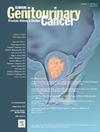Prognostic Impact of Bone Metastasis in Patients With Metastatic Urothelial Carcinoma Treated With Durvalumab With or Without Tremelimumab in the DANUBE Study
IF 2.3
3区 医学
Q3 ONCOLOGY
引用次数: 0
Abstract
Introduction
Bone metastases (BM) in metastatic urothelial carcinoma (mUC) may impact patient outcomes, but their independent effect with immune checkpoint inhibitors (ICIs) is uncertain. We aimed to assess the impact of BM and PD-L1 status on outcomes in mUC patients treated with ICIs.
Patients and Methods
This post hoc analysis of the DANUBE study included 1032 mUC patients treated with durvalumab (D), D + tremelimumab (T), or standard chemotherapy (SoC). Patients were categorized by BM status and assessed for median overall survival (mOS) and median progression-free survival (mPFS) stratified by PD-L1 expression and treatment arm.
Results
Among all patients enrolled in the study, those with BM had a lower mOS than those with no BM (8.7 vs. 15.8 months; P < .0001). Patients with BM and high PD-L1 expression, treated with D or D + T, had numerically longer mOS than patients with BM and low PD-L1 expression. In contrast, in the chemotherapy arm, there was no difference in mOS for BM or no BM, based on PD-L1 expression. Patients with BM had shorter mPFS compared to no BM (2.6 vs. 5.4 months; P < .0001). The study is limited by its post hoc nature.
Conclusion
Presence of BM was associated with worse outcomes across treatment arms. Patients with BM and high PD-L1 expression treated with D or D + T had longer mOS, suggesting potential benefits of ICIs in this subgroup. Consideration of BM and PD-L1 status in treatment decisions for mUC patients receiving ICIs may improve clinical outcomes.
DANUBE研究中使用或不使用特瑞莫单抗的转移性尿路上皮癌患者骨转移的预后影响
导言:转移性尿路上皮癌(mUC)的骨转移(BM)可能会影响患者的预后,但其对免疫检查点抑制剂(ICIs)的独立影响尚不确定。我们旨在评估BM和PD-L1状态对接受ICIs治疗的mUC患者预后的影响。患者和方法这项DANUBE研究的事后分析纳入了1032名接受durvalumab(D)、D+tremelimumab(T)或标准化疗(SoC)治疗的mUC患者。患者按BM状态分类,并按PD-L1表达和治疗组评估中位总生存期(mOS)和中位无进展生存期(mPFS)。结果在所有参与研究的患者中,有骨髓瘤患者的中位总生存期低于无骨髓瘤患者(8.7 个月 vs. 15.8 个月;P < .0001)。患有骨髓瘤且PD-L1高表达的患者在接受D或D+T治疗后,其mOS在数量上要长于患有骨髓瘤且PD-L1低表达的患者。相比之下,在化疗组中,根据PD-L1表达,有BM或无BM患者的mOS没有差异。与无骨髓瘤患者相比,有骨髓瘤患者的 mPFS 更短(2.6 个月 vs. 5.4 个月;P < .0001)。该研究的局限性在于其事后研究的性质。接受 D 或 D + T 治疗的 BM 和 PD-L1 高表达患者的 mOS 更长,这表明 ICIs 在这一亚组中具有潜在的益处。接受 ICIs 治疗的 mUC 患者在做出治疗决定时考虑 BM 和 PD-L1 状态可能会改善临床预后。
本文章由计算机程序翻译,如有差异,请以英文原文为准。
求助全文
约1分钟内获得全文
求助全文
来源期刊

Clinical genitourinary cancer
医学-泌尿学与肾脏学
CiteScore
5.20
自引率
6.20%
发文量
201
审稿时长
54 days
期刊介绍:
Clinical Genitourinary Cancer is a peer-reviewed journal that publishes original articles describing various aspects of clinical and translational research in genitourinary cancers. Clinical Genitourinary Cancer is devoted to articles on detection, diagnosis, prevention, and treatment of genitourinary cancers. The main emphasis is on recent scientific developments in all areas related to genitourinary malignancies. Specific areas of interest include clinical research and mechanistic approaches; drug sensitivity and resistance; gene and antisense therapy; pathology, markers, and prognostic indicators; chemoprevention strategies; multimodality therapy; and integration of various approaches.
 求助内容:
求助内容: 应助结果提醒方式:
应助结果提醒方式:


